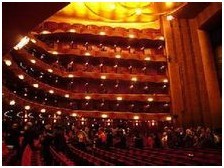

The Metropolitan Opera House is an opera house located on Broadway at Lincoln Square in the Upper West Side of Manhattan in New York City. Part of the Lincoln Center for the Performing Arts, the theater opened in 1966. It replaced the former Metropolitan Opera House at Broadway and 39th St. and is the current home of the Metropolitan Opera Company.
History
Although the house would not officially open for several more months, the first public performance at the new Metropolitan Opera House was a performance ofGiacomo Puccini's La Fanciulla del West on April 11, 1966 with Beverly Bower as Minnie, Gaetano Bardini as Dick Johnson, and CesareBardelli as Jack Rance. The production was attended by 3,000 high school students, and began with the playing of the National Anthem and a series of sound tests that included a loud chord from the orchestra and a blast from a shotgun.[1] The new building officially opened on September 16, 1966, with the world premiere ofSamuel Barber's Antony and Cleopatra.
While the Met Opera Company is on hiatus, the Metropolitan Opera House is home to the annual Spring season of American Ballet Theatre(ABT). It regularly hosts touring opera and ballet companies including the Kirov, Bolshoi, and the La Scala companies. In addition, the Met has presented recitals by Vladimir Horowitz,Kathleen Battle and others. Philip Glass's Einstein on the Beach was staged independently at the Met in 1976.
Several notable non-operatic performances occurred in 1986. On July 8, a gala fund raiser performance to benefit ABT andParis Opera Ballet saw the first joint performance in over ten years of ABT artistic director Mikhail Baryshnikov and Paris Opera Ballet Director Rudolf Nureyev.[2] On August 9 and 10, comedian Robin Williams recorded performances that were shown on HBO and released on compact disc under the title Robin Williams Live at the Met.[3] On October 19, 1986, the Opera House hosted Herbert von Karajan and the Berlin Philharmonic during their North American tour.[4]
In addition to regular Metropolitan Opera radio and television broadcasts, several other television programs have been produced at the Metropolitan Opera House including Danny Kaye's Look-In at the Metropolitan Opera (CBS, 1975) andSills and Burnett at the Met (CBS, 1976). In 1999 and 2001, the Opera House was the venue for the MTV Video Music Awards.[5][6]
Architecture
The Metropolitan Opera House contains 3,800 seats and 195 standing room places[7] and was designed by architect Wallace K. Harrison. Although west-east roads do not run through Lincoln Center itself, the Metropolitan Opera House is parallel to the block from West 63rd Street to West 64th Street. The rear of the House meets Amsterdam Avenue and the entrance to the Opera House is at Lincoln Center Plaza which begins at Columbus Avenue. The building is clad in white travertine and the east facade is graced with a distinctive series of five arches.
On display in the lobby, and visible to the outside plaza, are two murals created for the space by Marc Chagall. The murals are approximately 30 ft (9.1 m) by 36 ft (11 m). The south wall holds the work entitled The Triumph of Music while the north wall contains The Sources of Music.[8] In 2009, the opera's board of directors decided to use the paintings as collateral for a long-term loan which previously relied on cash for backing. Some sources estimate the value of the paintings at $20 million.[9]
The lobby is dominated by a cantilevered stairway that connects the main level with the lower level lounge and upper floors. Suspended in the lobby are 11 crystal chandeliers resembling constellations or starbursts. The auditorium contains 21 matching chandeliers, the largest of which measures 18 ft (5.5 m) in diameter. These were a gift of the Austrian government and designed by Dr. Hans Rath of J & L Lobmyer of Vienna. The chandeliers in the auditorium are raised to the ceiling prior to performances so as not to obstruct sightlines of the audience in the upper levels.[10] In 2008, the chandeliers were dismantled and sent to the Lobmyer workshops to be refurbished prior to the Met's 125th anniversary season. Workers re-wired the pieces and replaced any of the 49,000 crystals that were broken or missing.[11] The lobby also contains sculptures byAristide Maillol and Wilhelm Lehmbruck as well as portraits of notable performers and members of the Met company.
The auditorium is fan-shaped and decorated in gold and white with five levels above the orchestra. The square gold proscenium is 54 ft (16 m) wide and 54 ft (16 m) high. The main curtain of custom-woven gold damask is the largest tab curtain in the world. Above the proscenium is an untitled bronze sculpture byMaryCallery.[7]
The stage is 80 ft (24 m) deep from the curtain line to the rear wall. The overall dimensions of the stage with wing space are 90 ft (27 m) deep and 103 ft (31 m) wide.[7] The stage contains 7 full elevators that are 60 ft (18 m) wide, with double decks; three slipstages (large spaces on either side of and behind the main stage, each capable of holding a complete stage setting), the upstage one containing a 60 ft (18 m) diameter turntable; 103 motorized battens (linesets) for overhead lifting; and two 100 ft (30 m)-tall fully enveloping cycloramas. The large and highly mechanized stage and support space smoothly facilitates the rotating presentation of up to four different opera productions each week.



















